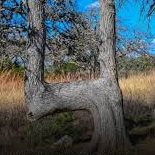
Nowadays, it’s easy to navigate thanks to the many apps and gadgets that make our everyday lives simpler.
But in the past, people had to find ways to mark trails, especially when traveling through dense forests.
If you’ve ever wondered how people managed to find the right direction without maps or GPS, here’s the answer:
Native Americans marked their paths by bending trees. How did they do it? They inserted a piece of wood or stone into a young tree’s trunk, causing the tree to grow around it and bend.
Of course, some trees naturally grow in unusual shapes due to nature. So how did indigenous people—and how can we—tell which bent trees were man-made?
The trees bent by Native Americans have distinctive features, like a noticeable “nose” or notch that sticks out at the end of the bend, as shown in the photo below.
Many of these trees are over 150, sometimes even 200 years old.
According to the National American Forests website:
“Across the U.S., you can find oddly shaped trees. Their trunks may have strange kinks or bends. While some are natural quirks, most are actually landmarks used by indigenous people. Native Americans bent young trees to create permanent trail markers, marking safe paths through rough terrain and pointing travelers toward water, food, or other important places. Over time, the trees grew, keeping their original shape but their purpose has been mostly forgotten as modern life developed. Though we no longer need these ‘trail trees’ to navigate, their historical significance is invaluable. Imagine the stories these trees could tell.”